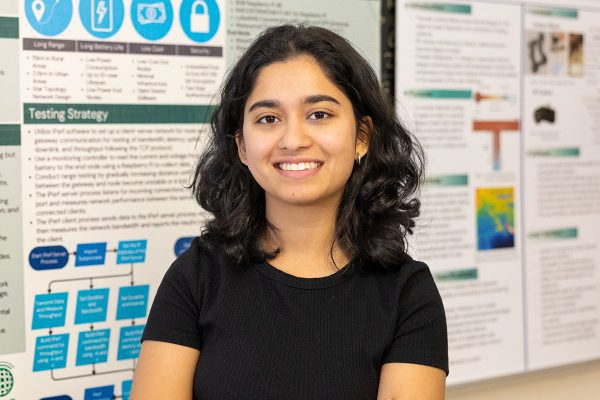From First Year to First Job: The 5 Tools Used by a Niner Engineer

Just like professionals have the necessary tools to complete the job successfully, students also need a success toolkit for their job of academics which will lead them to graduation. Niha Chandekar, a software engineering major graduating in December 2023, shares her own set of tools she has built during her time as a Niner.
Tool #1: A Personal Superpower
Upon entering UNC Charlotte, Chandekar quickly became aware of all the opportunities but also the challenge of competing priorities. “My biggest challenge was balance: performing well in school while still working, being in clubs and trying to spend time with friends and family,” she said. “Doing well in classes is a challenge within itself. Regardless of how fascinating all the classes are, they are also complex, fast-paced, and at times difficult.”
So she dug deep and discovered her own super power: “For me it was discipline. I quickly figured out how to study efficiently, since it is easy to get overwhelmed with all the information.”
Tool #2: A Platform to Pay it Forward
During her first year, Chandekar learned about and leveraged MAPS, the coaching program for Niner Engineers designed to Maximize Academic and Professional Success by connecting students to resources and opportunities. Sophomore year led her to actively participate in this program again, but this time as a peer coach. Chandekar mentored over 70 first-year engineering students and led them in many discussions on academic success and professional development. “Being a MAPS coach was particularly rewarding, allowing me to actively engage with students, including prospective students during open houses,” she said. “Answering their questions and addressing concerns felt like a full circle moment, reminiscent of my own freshman year uncertainties.”
Tool #3: A Unique Lens
Everyone has their own perspective, background and experiences, which help to curate their own unique lens used for their vision forward. Often, students find others with a similar lens and they connect to encourage each other and progress professionally. Chandekar used her lens as a woman in STEM to connect with others in WE Engage, or Women in Engineering Engage. This perspective as a woman also served as an inspiration and motivator for Chandekar, as she explains, “seeing new faces at the beginning of semester breakfasts in WE Engage made me realize that a lot more younger women were deciding to pursue engineering!”
Tool #4: An Experiential Learning Opportunity
The academic journey is often tightened by the wrench of experience, whether a job on campus, an internship or a co-op.

“I found out about a tech internship program through Hire-A-Niner, applied and got the job – so huge shout out to Hire-A-Niner!” said Chandekar. “I gained valuable industry experience as both a tech intern and a software engineering intern at Wells Fargo during the summers. These roles not only expanded my technical skills but also provided insights into the corporate landscape.” The internships led Chandekar into a a full-time job with the financial services giant. “With this experience, I’m going to work as a software engineer at Wells Fargo and plan on getting my master’s after working for a few years.”
Tool #5: Fellow Engineers
Your circle of Niners can be your strongest set of equipment. They can expand your knowledge, collaborate with you on projects and provide motivation. Chandekar added her network classmates, teams and faculty to her toolkit throughout her time on campus.
“My professors were a huge reason why I have succeeded in the College of Engineering,” said Chandekar. “Some of my professors, such as Dr. Xie, Dr. Arafa and Dr. Ravindran, had a strong ability to articulate complex concepts. They would also ask students for feedback, always seeking to know what works for us. It was a great motivation to keep pushing.”

Her peers were also essential gear. “I loved working in teams for my junior and senior design classes. The opportunity to work as an engineer while also managing the details as a team was an experience like no other. Together, we started with just calculations, research and discussion – and ended with a finished design that works. We finally combined everything we have learned over the years into this capstone. Doing this – and meeting all the people along the way – has been the highlight of my journey as an engineering student!”
As Chandekar graduates, she’ll take her toolkit into the professional world, adding to it along the way. Her growing collection of gear will equip her for lifelong learning toward an ever brighter future. As Chandekar sees it, “The more I learn, the more choices I have!”